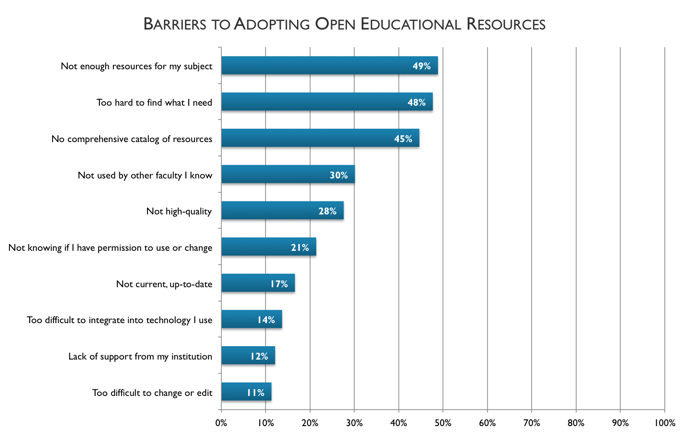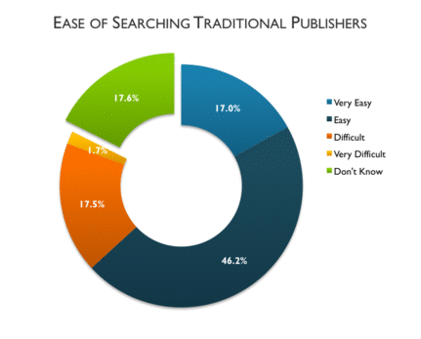You have /5 articles left.
Sign up for a free account or log in.
Open educational resources (OER) are showing signs of taking root in introductory courses, yet overall awareness of alternatives to traditional textbooks continues to lag, a new study found.
More than half (58.1 percent) of the faculty members surveyed for "Opening the Textbook: Educational Resources in U.S. Higher Education, 2015-16," a report released this morning by the Babson Survey Research Group, said they were not aware of OER or how instructors can use free or inexpensive alternatives to traditional textbooks in their courses.
Compared to when the Babson Group in 2014 surveyed faculty members about the same topic, the responses in this year’s report highlight some familiar challenges for instructors considering OER. Almost half of all respondents (48 percent) said open materials are too hard to find, and that they don’t have access to a catalog showing the open resources available to them (45 percent) or a helpful colleague who can mentor them (30 percent).
And while nearly nine out of 10 respondents (87 percent) said cost to students is an important or very important factor when considering which course materials to assign, many faculty members said there aren’t enough high-quality free or affordable course materials (28 percent) or simply enough open resources in their fields in general (49 percent) to make the switch from traditional textbooks.
“Faculty have a really strong level of displeasure with the cost of the materials, but many of them feel they don’t have any power to change it,” Jeff Seaman, co-director of the Babson Group, said in an interview. Alternatively, he added, faculty members are “unwilling to explore the lower-cost or free options, or they’re unaware of them.”
This is the first of three planned annual reports that will explore how open educational resources are making their mark on higher education. The research is supported by the William and Flora Hewlett Foundation.
The Babson Group surveyed a diverse group of faculty members for the report -- more than 3,000 in total, including those at two- and four-year institutions, working full and part time, on and off the tenure track, and with experience teaching online or blended courses.
The report also contains some good news for advocates of open resources and an indication that the strategy used by many OER initiatives and providers is paying off.
Colleges and publishers, seeking to save the most money on textbook costs for the greatest number of students, have frequently used large introductory courses as settings for OER pilots. To explore how OER titles are doing in the market compared to traditional textbooks, the Babson Group asked faculty members who were creating new courses, modifying existing or picking new readings in 14 common introductory courses which title in a selection of popular textbooks they planned to assign. The lineups included titles from OpenStax, a free textbook publisher based at Rice University.
With an average adoption rate -- how likely the surveyed faculty members were to pick the title -- of 10 percent, the OpenStax books were less popular than the average textbook (17 percent). Faculty members were also less likely to have heard of the titles (70 percent, versus 82 percent for the traditional textbooks).
Still, faculty members were nearly twice as likely to pick the OpenStax books in introductory courses than instructors generally picking OER titles across all courses (5.3 percent). And OpenStax has reached the 10 percent mark without the sophisticated marketing infrastructure that other textbook publishers have had decades to optimize, Seaman pointed out.
“That puts [OpenStax] in the same ballpark after only being on the market for a couple of years,” Seaman said. “They’re going where they think the biggest need is. In one sense this says they’re being reasonably successful at that.”
OpenStax published its first textbook in 2012. Four years later, the publisher estimates more than 690,000 students have used its books, totaling a savings of about $68 million.
"It's very gratifying to have this independent research validate what we've observed over the last two years," said Richard G. Baraniuk, the Victor E. Cameron Professor of Engineering, who founded OpenStax. "Faculty teaching introductory courses are rapidly accepting high-quality open educational resources from OpenStax. They are willing to make changes when they discover high-quality resources that are easy to adopt and are free or very low cost for students."
While awareness of open course materials has increased in the two years since the Babson Group last surveyed faculty members about course materials, a majority of instructors are still unaware of OER. In this year’s edition, nearly half of respondents (41.9 percent) said they are aware of OER and how they can use the resources in their courses, up from about one-third (35.1 percent) two years ago.
Even the faculty members who said they are aware of OER said they sometimes struggle to find the open resources they are looking to include in their courses. Of the faculty members who had an opinion about the ease of finding OER, about 60 percent of respondents described searching for OER as difficult or very difficult, compared to about 23 percent who said the same about searching for traditional textbooks.
Seaman said the results suggest an opportunity for OER providers to work together on how they can get the resources into the hands of faculty members. “The discovery issue is one area where OER have made very little -- if any -- progress,” he said.
The remaining two OER studies will include many of the same questions about awareness and barriers but go deeper into specific topics, Seaman said. Next year’s study will likely focus on faculty perception of textbook costs, he said.










